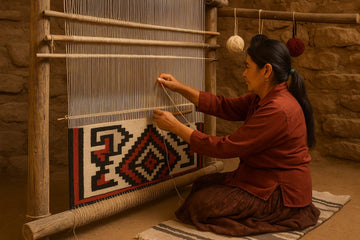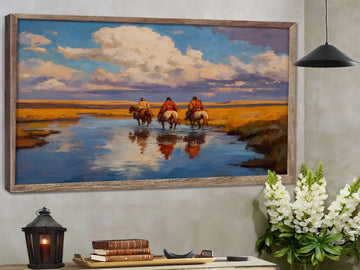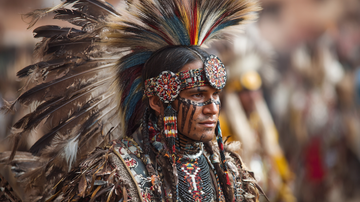In a world increasingly dominated by mass-produced goods, authentic Navajo rugs stand as remarkable testaments to centuries-old traditions of craftsmanship, artistry, and cultural heritage. These magnificent handwoven textiles represent far more than mere floor coverings—they are living pieces of Native American history, each thread carefully spun and woven with techniques passed down through generations of skilled artisans.

From the high desert mesas of the American Southwest emerges an art form that has captivated collectors, interior designers, and cultural enthusiasts for over three centuries. Traditional Navajo weaving combines practical functionality with profound spiritual significance, creating pieces that serve as both stunning home décor and meaningful cultural artifacts.
A Rich Tapestry of History
The story of Navajo rug weaving begins in the mid-1600s when Navajo women learned the ancient art from their Pueblo neighbors, who had been cultivating and weaving cotton since approximately 800 AD. However, it was the introduction of sheep by Spanish settlers that truly revolutionized Navajo textile production, providing the high-quality wool that would become synonymous with their craft.
Cultural Significance
According to Navajo legend, the art of weaving was gifted to the people by Spider Woman, a holy figure who taught them to create beauty and harmony through textile arts. This spiritual connection infuses every authentic Navajo rug with deeper meaning beyond its aesthetic appeal.
The earliest confirmed Navajo weaving dates to 1804, marking the beginning of what historians call the Classic Period—a golden age of textile production that established many of the design principles and techniques still employed by contemporary weavers. During this era, Navajo blankets and rugs were primarily created for personal use and trade, serving as both practical garments and valuable commodities.
Masterful Techniques and Premium Materials

Navajo weaver at traditional loom showing the weaving process
What sets authentic Navajo rugs apart from machine-made alternatives is their completely handmade construction. Every step of the process, from shearing the sheep to the final weaving, is performed by hand using traditional methods that have remained largely unchanged for centuries.
Wool Preparation
- Hand-shearing of Churro sheep wool
- Manual cleaning and debris removal
- Sun-drying for optimal fiber preparation
- Hand-spinning into strong, consistent yarn
Natural Dyeing
- Plant-based dyes from local flora
- Mineral pigments for earth tones
- Natural wool colors from different sheep
- Time-tested color-setting techniques
The traditional Navajo loom, constructed from wooden posts and tensioned with stones, remains the preferred tool for creating these masterpieces. Unlike modern industrial looms, this simple yet effective design allows weavers to maintain complete control over tension, pattern development, and the spiritual connection to their work.
Distinctive Regional Patterns
Navajo rug patterns vary significantly based on the geographic region where they're created, with each area developing distinctive design characteristics that reflect local traditions, available materials, and trading post influences. Understanding these regional differences is crucial for collectors and enthusiasts seeking authentic Native American rugs.
Ganado Rugs
Characterized by bold red backgrounds with black, white, and gray geometric patterns. These traditional Southwestern rugs feature large central motifs surrounded by intricate borders.
- Classic red, black, white palette
- Central diamond or cross designs
- Double or triple borders
Two Grey Hills
Renowned for their sophisticated natural color schemes using undyed wool in shades of white, brown, black, and gray. These represent the pinnacle of fine handwoven textiles.
- Natural undyed wool colors
- Extremely fine weave quality
- Complex geometric patterns
Teec Nos Pos
Known for their vibrant multi-colored designs and intricate geometric patterns. These collectible Navajo rugs often feature the most complex weaving techniques.
- Bright, varied color palette
- Most intricate design complexity
- Multiple pattern elements

Grid showing examples of different regional Navajo rug patterns side by side
Sacred Symbols and Their Meanings
Every element in traditional Navajo rug designs carries profound cultural significance. These symbols connect the physical textile to the spiritual world, making each piece a meditation on Navajo cosmology and beliefs.
Common Sacred Symbols
- Crosses: Represent Spider Woman, the holy figure who taught weaving
- Diamonds: Symbolize the four sacred mountains and Navajo homeland
- Zigzag Lines: Represent lightning and divine power
- Triangular Shapes: Mountains and connection to Mother Earth
Spiritual Elements
- Spirit Lines: Intentional breaks in borders to release spiritual energy
- Yei Figures: Sacred beings from Navajo ceremonial traditions
- Storm Patterns: Seasonal rains essential for agricultural success
- Tree of Life: Connection between earth and sky
It's important to note that authentic weavers often include small intentional "imperfections" in their work. These aren't mistakes but deliberate spirit lines that ensure the weaver's soul isn't trapped within the textile, allowing their creative energy to flow freely to future projects.
Preserving Your Investment: Care and Maintenance
Proper care of your authentic Navajo rug ensures that this valuable piece of Native American art will remain beautiful and structurally sound for generations. Understanding the specific needs of handwoven wool textiles is essential for preservation.
Recommended Practices
- Regular gentle vacuuming with smooth floor attachment
- Rotate periodically to ensure even wear
- Keep away from direct sunlight to prevent fading
- Use rug pads to prevent slipping and add cushioning
- Professional cleaning for deep stains
- Store flat or rolled (never folded) for long-term preservation
What to Avoid
- Never machine wash or use steam cleaning
- Avoid beater bars or aggressive vacuuming
- Don't iron or apply direct heat
- Never shake vigorously to clean
- Avoid harsh chemicals or bleach-based cleaners
- Don't place in high-traffic areas without protection
Professional Advice
For valuable or antique pieces, consult with specialists in Native American textile conservation. Professional cleaning and restoration services can address significant damage while preserving the rug's authenticity and value.
Collector's Guide: Identifying Authentic Pieces
With the growing popularity of Southwestern décor, the market has seen an influx of machine-made imitations. Learning to identify genuine handwoven Navajo rugs protects your investment and ensures you're supporting authentic Native American artisans.

Close-up comparison showing authentic vs. machine-made rug details
Weave Quality and Construction
Authentic handwoven textiles display slight irregularities that reflect the human touch. Look for:
- Variation in yarn thickness and tension
- Four finished edges (selvedges) with no fringe
- Visible weft returns at the edges
- Natural wool texture and slight imperfections
Materials and Dyes
Genuine pieces use specific materials that affect both appearance and feel:
- 100% wool construction (no synthetic blends)
- Natural variations in color within dyed areas
- Appropriate weight and thickness for hand-spun yarn
- Characteristic wool smell when new
Documentation and Provenance
When investing in collectible Native American rugs, proper documentation adds significant value:
- Artist signature or identification
- Certificate of authenticity
- Trading post or gallery documentation
- Regional and pattern identification
Modern Applications and Interior Design
Today's interior designers and homeowners increasingly recognize Navajo rugs as versatile design elements that bring warmth, authenticity, and cultural richness to contemporary spaces. These pieces work beautifully in settings ranging from rustic cabins to modern urban lofts.
Living Spaces
Perfect as statement pieces in living rooms, adding texture and cultural depth to any décor style.
Bedrooms
Create serene, grounded environments with natural wool textures and earth-tone patterns.
Wall Art
Display smaller pieces as textile art, showcasing the intricate patterns and craftsmanship.
Design Tips
Color Coordination
Use the rug's natural earth tones as inspiration for room palette, complementing with neutral furniture and natural materials.
Scale and Placement
Consider the room size and traffic patterns. Larger pieces work well as focal points, while smaller rugs add accent color.
When incorporating these pieces into your home, remember that you're not just adding décor—you're preserving and honoring a living cultural tradition. Each authentic Native American textile carries stories, traditions, and the spiritual energy of its creator.
Investment Potential and Market Trends
High-quality authentic Navajo rugs have demonstrated remarkable stability and growth in the collectibles market. As appreciation for traditional crafts increases and the number of skilled weavers remains limited, these pieces continue to appreciate in value while serving as tangible connections to American cultural heritage.
Factors Affecting Value
- Weave quality: Tighter, finer weaves command higher prices
- Pattern complexity: Intricate designs like Teec Nos Pos are most valuable
- Size: Larger pieces generally bring premium prices
- Age and provenance: Historical pieces with documentation
- Condition: Well-preserved examples maintain value better
- Regional style: Certain patterns are more sought-after
Market Outlook
- Growing appreciation for handmade crafts
- Increased interest in cultural preservation
- Limited supply as fewer weavers continue tradition
- Strong demand from collectors and designers
- International recognition and export market
- Museum acquisitions driving institutional demand
Investment Considerations
While collectible Navajo rugs can appreciate significantly, purchase them primarily for their beauty and cultural significance. The best investments come from pieces you'll enjoy living with, whether or not they appreciate in monetary value.
Where to Find Authentic Pieces
Finding genuine handwoven Navajo rugs requires knowledge of reputable sources and red flags to avoid. Whether you're seeking a statement piece for your home or beginning a serious collection, understanding the marketplace is essential.
Trading Posts
Traditional sources on or near reservations, offering direct-from-artist purchases with authentic documentation.
- Established relationships with weavers
- Cultural context and education
- Often best prices for quality
Specialized Galleries
Curated collections with expert authentication and detailed provenance documentation.
- Professional authentication
- Detailed artist information
- Collector-quality pieces
Online Retailers
Reputable websites like RezSpirit's rug collection offer authenticated pieces with detailed descriptions.
- Wider selection and price ranges
- Detailed photography and descriptions
- Return policies for authentication issues
Red Flags to Avoid
- Prices that seem too good to be true
- Sellers unable to provide authenticity documentation
- Machine-perfect uniformity in weaving
- Synthetic materials or obvious chemical dyes
- Fringed edges (not traditional for Navajo rugs)
- Vague or missing artist information
- No return policy or authentication guarantee
Supporting Native American Artisans
When you purchase authentic Navajo rugs, you're directly supporting Native American families and helping preserve cultural traditions that might otherwise disappear. This economic support is crucial for maintaining the incentive for young people to learn these time-intensive skills.
Economic Impact
- Provides sustainable income for rural families
- Supports traditional lifestyle and values
- Funds education and cultural programs
- Maintains reservation-based economies
Cultural Preservation
- Encourages intergenerational skill transfer
- Maintains traditional knowledge systems
- Preserves spiritual and cultural practices
- Documents regional variations and techniques
The time investment required for these pieces is substantial—a single high-quality rug may take months to complete. By choosing authentic pieces from reputable sources, collectors ensure that this vital cultural tradition continues to thrive while building a meaningful collection of functional art.
Bringing Timeless Beauty Into Your Home

Beautiful interior shot showing Navajo rug in modern home setting
Navajo rugs represent far more than decorative objects—they are portals to a rich cultural heritage, testimonies to human creativity, and bridges between ancient wisdom and contemporary living. Each piece tells a story that spans generations, connecting the modern collector to traditions that have survived centuries of change.
Whether you're drawn to the bold geometric patterns of Ganado designs, the sophisticated neutrals of Two Grey Hills pieces, or the complex intricacies of Teec Nos Pos weavings, investing in authentic pieces means becoming a steward of this remarkable art form. Your purchase supports contemporary artisans while preserving techniques that might otherwise be lost to modernization.
Explore Our Curated Collection
Discover the perfect piece for your home from our carefully authenticated selection of traditional Native American rugs.
As you begin or expand your collection, remember that each authentic Navajo rug is a unique creation. No two pieces are exactly alike, reflecting the individual artisan's style, available materials, and personal interpretation of traditional patterns. This uniqueness makes every piece precious—a one-of-a-kind artwork that will bring beauty, meaning, and cultural richness to your space for generations to come.
Ready to discover the perfect piece for your collection?
Browse our extensive selection of authenticated Native American rugs and find the piece that speaks to your personal style and space.





